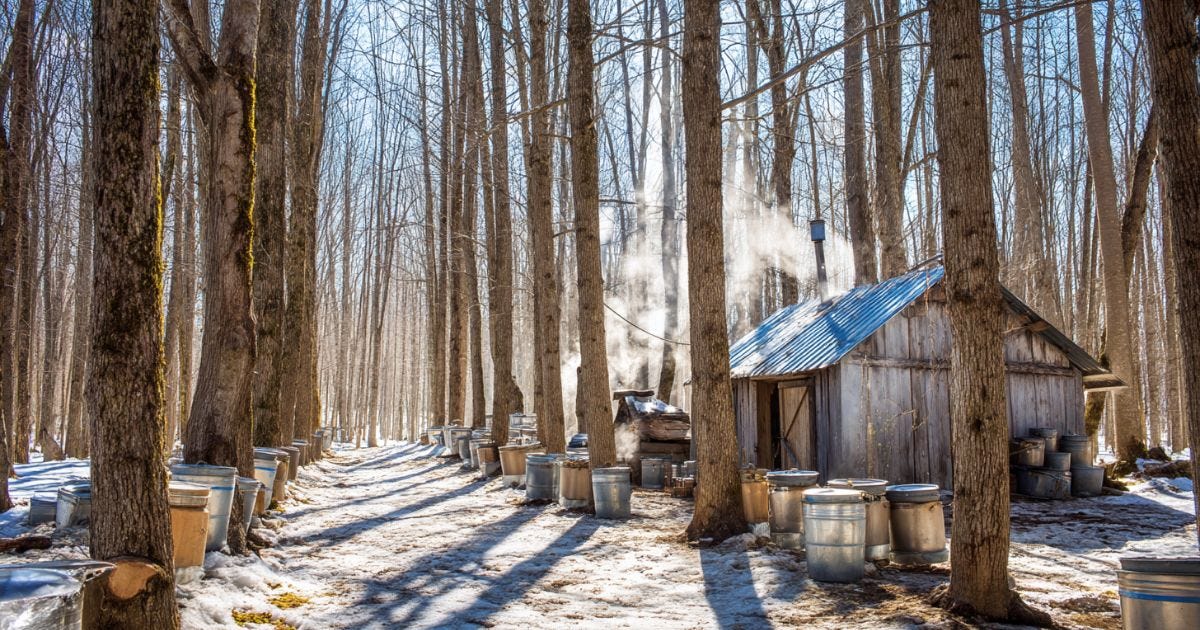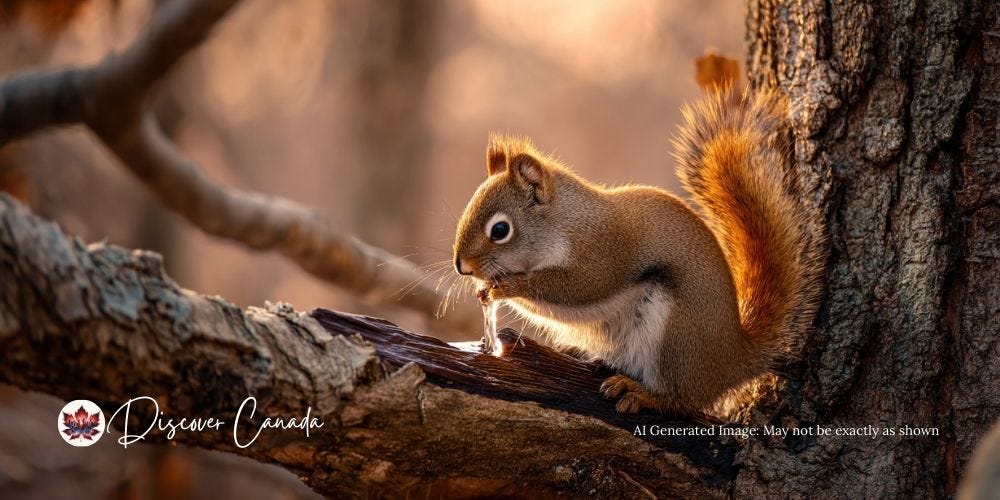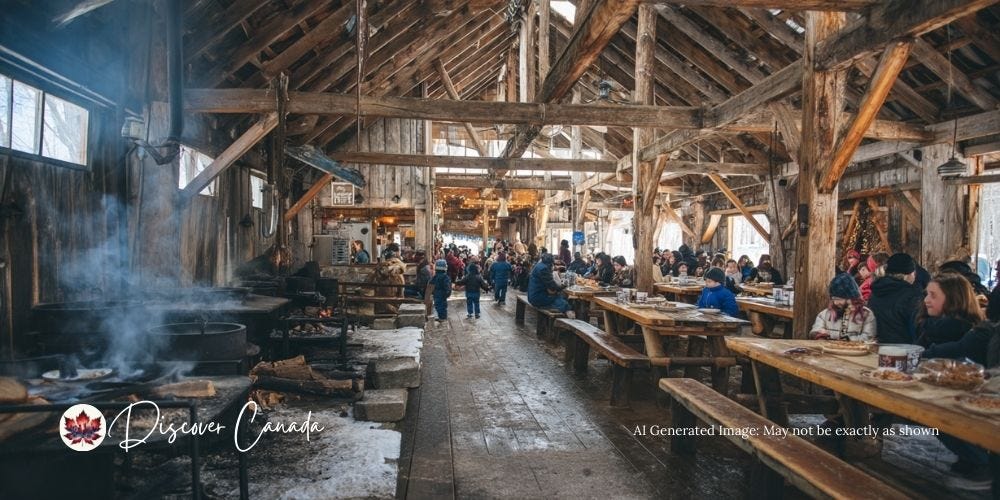From Sap to Story: Maple Syrup in Canada
Maple syrup legends, traditions, and sugar shacks capture the essence of Canada’s sweetest heritage.
🎧 Listen While You Read
Hit play and let the story carry you through the sugar bush, from ancient legends to sweet traditions.
Introduction
The morning mist clings to the trees as a faint sweetness drifts through the cool air. In the sugar bush, metal spouts drip clear sap into waiting pails, each drop a quiet promise. Inside the shack, steam billows upward, filling the rafters with the scent of woodsmoke and caramelizing sugar. For generations, this has been more than a harvest — it’s a ritual, a celebration, a legend. From the first Indigenous stories of squirrels and spirits to today’s sugar shacks alive with laughter, maple syrup has always been Canada’s sweetest thread of heritage.
Key Takeaways 🍁
🌿 Born in Indigenous legends and traditions, maple syrup carries sacred meaning.
🔥 Settlers transformed the art into the sugaring-off rituals we know today.
🍴 Québec sugar shacks and snow taffy keep the spirit alive every spring.
🌍 Maple syrup is not just food — it’s identity, culture, and community.
The Legends in the Trees
Long before settlers arrived, maple syrup lived in stories told around the fire. Each nation carried its own version, each legend reflecting the bond between people and the sugar maple.
One tale, told among the Mohawk people, begins with a squirrel. Hunters noticed the animal, vivacious, drinking from a broken branch. Curious, they tried the clear liquid themselves — and found sweetness. What they tasted was sap, a hidden gift of the trees, revealed by a small creature’s thirst (source).
Another story belongs to Woksis and Moqua, figures of early legend. One day, Moqua, running out of water to cook moose meat, filled her pot with maple sap instead. As the fire burned, the sap thickened into syrup, a discovery made not through science, but by accident — and joy.
And then there is Nanaboozho’s lesson, told in Anishinaabe and Abenaki traditions. In the earliest times, it is said, sap flowed thick and sweet straight from the trees. But Nanaboozho, a trickster-teacher, feared humans would grow lazy. To remind them of respect and effort, he thinned the sap with water, so each spring people would have to work, gather, boil, and wait. A reminder that sweetness is earned, not given.
Each of these stories — the squirrel’s quick tongue, Moqua’s accident, Nanaboozho’s lesson — is different, but together they carry the same truth: maple syrup is not just sugar. It is a gift, tied to respect, patience, and the rhythm of the land.
When Settlers Learned the Sweet Secret
By the time Europeans set foot in the dense maple forests of the St. Lawrence Valley, Indigenous peoples had already perfected the spring ritual of sap gathering and boiling. What seemed like a miracle to the newcomers was, in truth, a practice grounded in centuries of observation and tradition.
Early explorers struggled even to describe it. In 1557, French writer André Thévet compared the sweet liquid from the “large walnut tree” to fine wine — amazed that something so delicate could flow straight from the bark (source). Settlers, eager to survive harsh winters, learned quickly from their Indigenous neighbours: hollowed-out logs became troughs, clay pots boiled over open fires, and slowly, a new tradition of syrup-making took shape.
But while Europeans adopted the practice, they also reshaped it. Iron kettles replaced clay pots. Metal spouts replaced sharpened sticks. With each change came a shift — the methods grew more efficient, but the process moved further away from the ceremonial meanings carried by Indigenous communities.
Still, the awe remained. Imagine a settler family in the 1600s, standing in the cold forest as sap dripped steadily into wooden pails, the promise of sweetness in a season otherwise marked by hunger. For them, it was more than sugar. It was survival, warmth, and hope that spring had returned.
Québec Sugar Shacks and the Spring Ritual
By the 1800s, the making of maple syrup had grown beyond survival into celebration. Nowhere is that more alive than in Québec, where the cabane à sucre — the sugar shack — became both kitchen and community hall.
Picture it: families bundled in wool and fur, arriving by sleigh through the last crusts of winter snow. Inside, heat radiates from boiling kettles as syrup thickens to amber, filling the shack with a fragrance that clings to hair and clothes. Outside, children wait with eager eyes as hot syrup is drizzled onto clean snow, rolling it into sticky ropes of tire d’érable — maple taffy, still warm from the fire.
The sugaring-off was more than food. It was laughter, music, and a seasonal marker — the proof that winter’s grip was loosening. Maple syrup wasn’t just poured on pancakes; it was woven into the rhythm of rural life. Songs were sung, fiddles played, and stories passed from one generation to the next over bowls of thick pea soup and fresh bread, always with syrup on the table.
Even today, sugar shacks remain pilgrimage sites each spring, drawing locals and visitors alike into the warmth of a ritual that is part feast, part festival, and entirely Canadian.
Sweetness and Struggle — Modern Anecdotes
Maple syrup may be sweet, but its story has always had shadows. Behind the steam-filled shacks and children’s laughter lies a world of power, struggle, and even crime.
In 2012, Canadians woke up to headlines that sounded more like a movie script: thieves had siphoned off millions of dollars’ worth of syrup from Québec’s strategic reserve — nearly 3,000 tonnes gone in what would be called The Great Maple Syrup Heist. Barrels were rolled out of warehouses under the cover of night, syrup replaced with water, and when the scheme was uncovered, it revealed just how valuable this golden liquid had become on the world stage.
Not every battle has been so cinematic. Small producers like Angèle Grenier found themselves fighting Québec’s powerful federation of maple producers for the right to sell independently. For her, syrup was not just a commodity but a family craft, one she refused to surrender. Her legal battle became a symbol of the tension between tradition and regulation, as well as between freedom and control.
And then there is the newest struggle — the changing climate. Syrup makers whisper of seasons arriving too soon, freeze-thaw cycles shifting, and sugar maples “waking up” before their time. What was once predictable now feels fragile, reminding us that even legends must bend to nature’s will.
Maple Syrup in Canadian Identity
Ask someone outside Canada what symbol they think of first, and chances are it’s the maple leaf. But beneath that emblem lies the taste of maple syrup — a sweetness braided into the country’s very identity.
It’s there at the breakfast table, poured over pancakes and waffles. It’s there in craft kitchens, where chefs fold it into glazes for salmon, vinaigrettes for crisp salads, or decadent desserts that taste of forest and fire. Bartenders swirl it into cocktails, pairing bourbon with a ribbon of maple to remind you that this is no ordinary sugar.
Maple syrup travels, too. Canada produces nearly three-quarters of the world’s supply, and barrels of amber, golden, and dark syrup flow to far-off kitchens. Yet for Canadians, it remains more than an export. It’s a reminder of who we are: a people shaped by long winters, fleeting springs, and the patience to turn a thin trickle of sap into liquid gold.
Every March and April, when the trees awaken and the sap begins to flow, Canada awakens too. The season is short, but the story is eternal. Maple syrup isn’t just sweetness — it’s belonging, a taste of home, a legend retold with every pour.
Pro Tip 🍯
When you’re buying maple syrup, look for the words “100% Pure.” Skip the pancake syrups that are mostly corn sugar. Each grade tells a story of its own: Golden for light and delicate, Amber for rich balance, Dark for bold, caramel depth. Try them side by side — you’ll taste the seasons themselves.
Conclusion
The sugar bush falls quiet as evening settles. Steam no longer rises from the shack, and the pails are empty, waiting for tomorrow’s drip. Yet the story lingers — in the sweetness poured on your plate, in the legends told by firelight, in the laughter echoing through sugar shacks each spring.
Maple syrup is more than Canada’s flavor. It is its heartbeat — a reminder that patience yields sweetness, that tradition carries forward, and that some legends can be tasted. Each spring, when the sap rises, Canada remembers its sweetest story.








